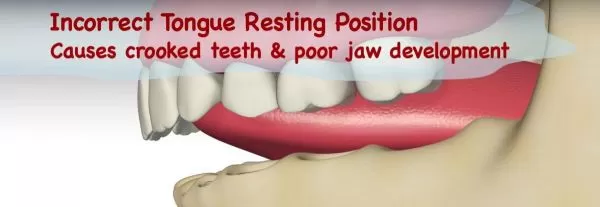
FAQ Topic
Orthodontic Relapse and the Tongue
 The teeth exist in a balance between the inner forces of the tongue and the outer forces of the cheek and lip muscles. When growth and development is optimal, this results in a harmonious relationship between the teeth and the bite.
The teeth exist in a balance between the inner forces of the tongue and the outer forces of the cheek and lip muscles. When growth and development is optimal, this results in a harmonious relationship between the teeth and the bite.Tongue posture and function is detrimental to tooth and orthodontic health. When the tongue rests low in the mouth or thrusts during swallowing, it provides consistent patterns of pressure that can affect tooth position (think braces and how those tiny movements over a long time have a big change on the way a smile looks!). Spaces between teeth can be difficult to close and often unstable after ortho treatment, resulting in relapse.
When the tongue rests on the floor of the mouth, the palate is often underdeveloped and therefore, too narrow to fit all teeth evenly. This can cause problems like a gummy smile, poor tooth alignment, traumatic or uneven bite, and even contribute to clenching and grinding and airway issues like snoring.
Tongue posture is always determined by placement of the tongue on the roof of the mouth, although this can be difficult for patients with sub-optimal palatal growth (narrow, high, or vaulted palate) or a tongue-tie restriction. Talk to our specialists to see if treatments like palatal expansion, myofunctional therapy, sleep study or tongue-tie release are right for you.
